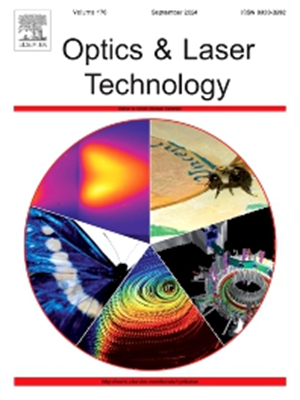用于编码器应用的激光诱导波纹的纳米压印复制
IF 5
2区 物理与天体物理
Q1 OPTICS
引用次数: 0
摘要
激光诱导周期表面结构(LIPSS)具有独特的光学性能,可用于光学编码器的暗标记,但其直接激光制造成本高且速度慢。本研究介绍了一种具有成本效益和可扩展性的替代方案:热纳米压印复制LIPSS柔性,金属化聚对苯二甲酸乙二醇酯(PET)薄膜。LIPSS最初采用皮秒激光烧蚀在不锈钢上制备,然后在不同温度下通过热纳米压印复制到铝涂层PET薄膜上。原子力显微镜证实了成功的复制,在180°C下获得了最佳保真度,保留了LIPSS约450 nm的周期性,同时将波纹高度从钢母片的114 nm转移到PET复制品的80 nm。使用UV-Vis-NIR光谱和聚焦激光束反射进行的反射率测量表明,PET薄膜上的波纹区域和非波纹区域之间存在显着差异,可与钢母片媲美,足以用于光学编码器应用。聚焦激光反射扫描的频域分析证实了主模和复模具有一致的周期性。这些结果表明,热纳米压印是一种可行的、可扩展的、具有成本效益的技术,可以将LIPSS复制到柔性基板上,从而可以生产用于各种传感和定位应用的高对比度光学编码器刻度。本文章由计算机程序翻译,如有差异,请以英文原文为准。
Nanoimprint replication of laser-induced ripples for encoder applications
Laser-induced periodic surface structures (LIPSS) offer unique optical properties as dark marking which is applicable for optical encoders, but their direct laser fabrication is costly and slow. This study introduces a cost-effective and scalable alternative: thermal nanoimprint replication of LIPSS onto flexible, metallized polyethylene terephthalate (PET) film. LIPSS were initially fabricated on stainless steel using picosecond laser ablation and then replicated onto aluminum-coated PET film via thermal nanoimprinting at varying temperatures. Atomic force microscopy confirmed successful replication, with optimal fidelity achieved at 180 °C, preserving the ca. 450 nm periodicity of the LIPSS while transferring ripple heights from 114 nm in steel master to 80 nm in PET replica. Reflectance measurements using UV–Vis-NIR spectroscopy and focused laser beam reflection demonstrated significant contrast between rippled and not rippled areas on the PET film, comparable to the steel master and sufficient for optical encoder applications. Frequency domain analysis of focused laser reflectance scans confirmed consistent periodicity in both master and replica. These results demonstrate that thermal nanoimprint is a viable, scalable, and cost-effective technique for replicating LIPSS onto flexible substrates, enabling the production of high-contrast optical encoder scales for various sensing and positioning applications.
求助全文
通过发布文献求助,成功后即可免费获取论文全文。
去求助
来源期刊
CiteScore
8.50
自引率
10.00%
发文量
1060
审稿时长
3.4 months
期刊介绍:
Optics & Laser Technology aims to provide a vehicle for the publication of a broad range of high quality research and review papers in those fields of scientific and engineering research appertaining to the development and application of the technology of optics and lasers. Papers describing original work in these areas are submitted to rigorous refereeing prior to acceptance for publication.
The scope of Optics & Laser Technology encompasses, but is not restricted to, the following areas:
•development in all types of lasers
•developments in optoelectronic devices and photonics
•developments in new photonics and optical concepts
•developments in conventional optics, optical instruments and components
•techniques of optical metrology, including interferometry and optical fibre sensors
•LIDAR and other non-contact optical measurement techniques, including optical methods in heat and fluid flow
•applications of lasers to materials processing, optical NDT display (including holography) and optical communication
•research and development in the field of laser safety including studies of hazards resulting from the applications of lasers (laser safety, hazards of laser fume)
•developments in optical computing and optical information processing
•developments in new optical materials
•developments in new optical characterization methods and techniques
•developments in quantum optics
•developments in light assisted micro and nanofabrication methods and techniques
•developments in nanophotonics and biophotonics
•developments in imaging processing and systems

 求助内容:
求助内容: 应助结果提醒方式:
应助结果提醒方式:


